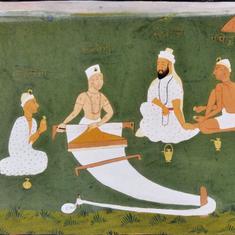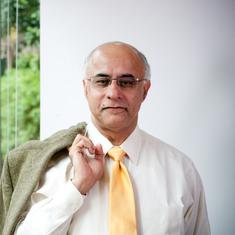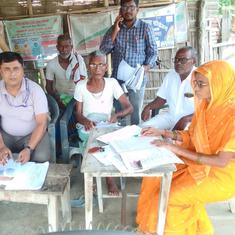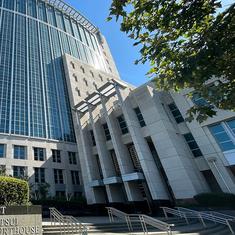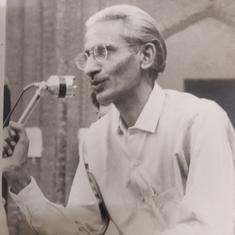“Arre Professor saab, what is wrong with you today? Why are you so quiet and withdrawn? After all, we are going to see your very own at today. If anybody should be unhappy, it should be me. I am losing you, na? Arre, today is a big day for you. It’s your first own at. It’s your nishana, your ashiana. C’mon, c’mon, be happy.” Khanna’s elephantine as well as infantile attempts to cheer me up have penetrated to Roshni. She leans behind and speaks, “Khanna saab, just leave him alone. He is a tremendously moody person. He will snap out of it in his own time. Or maybe, he won’t. Our saying or doing anything will not help. He builds up worlds in his head and finds his own way out of them. Here, you please have a sandwich. Embee, here’s one for you too.”
Have I really? Have I really, Roshni, my dear? Have I really built up this world in my own head? That’s what I keep thinking while mechanically chewing the sandwich. In all fairness, I can’t also help noticing that Roshni is hardly behaving like an adulteress now, or at least, she is not behaving like a person with a guilty conscience or one with anything to hide. She is perfectly free, completely unselfconscious and keeping up a running banter with both the Khannas. So what? Am I building this in my own head? Or is it that Roshni actually has no guilt on her conscience about what she is doing? That is, if she is actually doing what I think she is doing. Does her guilelessness also mean guiltlessness? Or is it that I am just going plain batshit crazy?
The funny thing is that I have never suspected Roshni of anything like this ever earlier and now suddenly this has burst upon me with a full-blown certainty. There, she just patted Rocky on the shoulder to show him a signboard, and I almost leapt out of my seat to physically force them apart.
“Here we are uncle. Here we are. This is the main sector Road that leads up to Glenmont Greens. Won’t be long now. We should be able to see the site in ten minutes.” This communication from Rocky forces me to snap out of my thoughts and look around. Here we are? Where are we? This looks like some sort of desolate moonscape. A road that has been ravaged by earthmovers on either side and scarred in the middle by some bulldozer run amok...this is “here we are”? The Innova is lurching from side to side, splashing through pools of rancid water and Rocky too is muttering about the damage to his beloved car. On either side are glass and concrete buildings adorned with the names and logos of the world’s best-known companies and in-between them, like cavities in teeth, are empty plots or half-constructed shells of buildings. There are people, smartly dressed in office formals and carrying laptops bags, who, for some reason, are rushing across the road. There seems to be an urgency and purposeful efficiency about this place that, for me at least, does not correspond with the physical reality. It all feels a little disembodied, one psychotropic remove from the “here and now”. Like a play where the actors are merely rehearsing and all the props have not yet been put in place, but somehow, someone has collected the ticket money, let the audience in and raised the curtains. Just what is this? And just where are we?
Roshni too seems a little shocked. “Khanna saab, the last time we came here, this was a proper road and there were lots of trees on either side. I remember two-way traffic with a paved central verge. There were light poles and trees on the central verge too. Just what happened here?”
“Progress happened here, beta, progress. and, sometimes, this is the price of progress. But, why worry? It’s for the better and is only temporary. The fact is that the builders have now got this converted to a sector Road, so the government is now putting in drains on either side, that’s why all this is happening, you know, progress.”
“But the central verge?” Roshni’s incredulity is apparent and in spite of all my problems, I cannot help but be interested in the conversation. This urban planning lunacy seems to be, in orders of magnitude, higher than the craziness in my head.
“Beta, that is for the Rapid Metro. You know, Gurgaon needs to be serviced by its own mass rapid transit system. It is, after all, a smart city, a twenty-first-century city. So, this is progress.”
Wow! So, that’s what it is. Silly, deluded me. I thought it was a case of the urban planners mistakenly interpreting the urban planning manual in reverse...or perhaps perpetrating a horrible practical joke on the gullible public. In fact, I can even imagine them huddled around a conference room table with the projector displaying the “action points” of the final meeting.
“First we do the horticulture, you know, plant all the trees. One must first think of the environment, na? Then, we build the buildings. let them out on rent or sell them. Revenue is important. Then, we worry about the roads. After all, all those buildings will have all those people and they will need to move to and fro. See, we always think about the convenience of the people. So, now we build the roads and the roads...oops! Those roads will have cars which will need to stay tethered to the buildings...no matter, we let the people park on the roads for now. Oh ho! What a nuisance, those people will have bodily movements, you know. They will eat, shit, etc. And will need water, electricity and suchlike. Okay, so next, we dig up the roads and lay in the sewer pipes, the water connections, etc. By now, the rush of people will be too much, the roads will be clogged with cars with no parking space, so let’s now build a rapid metro. See, this is the modern thing to do; it’s happening all over the world. of course, we will build it on top of the existing roads or atop whatever by now passes for a road.”
All action points discussed, the meeting is just about coming to a close and I can just imagine some bright-spark Babu – perhaps the senior-most of them all – maybe one of the exalted IAS, rapping the table and pronouncing, “I have a value addition to maximise effIciency, reduce downtime and rationalise costs.
Of course, everybody is now waiting, faces aglow with excitement, fingers poised over laptops to minute these words of divine wisdom and transform them into an “order”. “Let us,” says he, “do it all together. We will build the drainage system and the metro rail together. That way we will maximise efficiency and rationalise costs. of course, after that we can worry about the horticulture and the parking issues. That’s later. We need something to do tomorrow too; after all, nation-building is a continuous process. But let’s be efficient and offer the best developmental strategy and execution to the public.”
“Let’s do it together boys,” he says and voila! here we are...sloshing through yet another pothole – and wow – here’s a herd of goats! Here we are with the roads dug up on both sides, and not to miss, also the middle. After all, this is “maximised” and “rationalised” progress.
Imagined scenarios aside, the fact is that with the astounding clarity of thought and purity of intelligence that these people are known for, the civic planners invested in plantation and horticulture 10 years ago. Three months ago groves of fragrant neem and flowering mayflower trees over tens of miles were uprooted to lay in the roads. While the tar macadam was drying on these shining ribbons of progress, the civic planners were once again struck by a bolt of inspired vision – sewers! Or perhaps they were working to the agenda. So, they have now dug up all the roads to lay in the sewer pipes. No doubt, displaying the same brilliance of sequential logic, they will arrive at telephone lines, fibre optic cabling and electric wiring too. Till then, we gaze open-mouthed and unbelieving, pinching ourselves to wake up, reminding ourselves of the epochal moment at which we stand in history – this is a civic dream unfolding, a vision becoming real, the first Indian city of the millennium is taking shape before our own eyes. What’s more? As a shining example of originality of thought and stout independence of spirit, we have declined to copy examples from around the world. Hell! America made her cities a hundred years ago, we will make our own, in our own way. We are the children of the millennium and this is our way and if it is different from what our ancestors did four thousand years ago in Harappa and Mohenjo-Daro, so be it. Yes, even today, those sites are held up to the world as examples of superb town planning, but wait...it took four thousand years for that to happen. No doubt, four millennia later, Glenmont Greens and its environs will be the new poster boys of livable, breathable, walkable cities.
FatBum is nattering on and on to Roshni about the “politician builder nexus”, “driven by investors not end users”, “difficulties of land acquisition”, etc. It is a boring and needlessly defensive monologue...I know all this.
In spite of all evidence to the contrary, this academic is not exactly an ingénue in these matters, But, right now he could not care less. He has dismissed this as the madness of the metropolis. Right now, he is thinking of getting back at Roshni. How dare she do this to him? Was this what she learnt at her “Hindi-Medium school” at Meerut? Is this why he is building a home with her? So, what should he do now?
“Will you snap out of it or will I have to make you?” Roshni is shaking my shoulders and hissing at me. The car has stopped and I can make out she is very perturbed. The schoolgirl-look is coming apart; there are sweat stains on the pristine white of the top under the armpits, the hair is in disarray and for the first time I am seeing her in a Virago mode. Well, in all fairness, I have never seen her in an adulteress mode either. Shaken out of my stirring thoughts, I see that Rocky is helping her out of the car. One foot in the car, one foot across the puddle in which he has perhaps deliberately parked, and with the wide-open stance of Hercules, he actually swings Roshni out of the car on to dry land. While I have been dreaming about coffee, some things are happening right in front of my eyes. I don’t want to see this anymore. I want us to go back.

Excerpted with permission from The Glass House: A Year of Our Days, Chanchal Sanyal, Rupa Publications.

